Our Handlock deck list guide goes through the ins-and-outs of this midrange deck in Descent of Dragons meta! This guide will teach you how to mulligan, pilot, and substitute cards for this archetype!
Introduction to Handlock
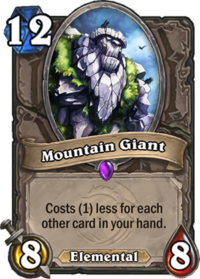
Handlock is one of the oldschool Hearthstone archetypes. It didn’t take player very long to discover the amazing synergy between Warlock’s Hero Power (Life Tap) and some cards that benefit from having many cards in the hand, such as Mountain Giant or Twilight Drake. The deck came back in many forms over the years, but it always had a slow start and then powerful mid game thanks to the big minions it could drop.
The deck was brought back again in Descent of Dragons, taking a lot from the main expansion’s theme – Dragons. Warlock has got two very powerful Dragon synergies – Nether Breath and Crazed Netherwing. While the latter is more generic “board clear on a stick” type of card and the deck could do without it (because Warlock has access to some other solid AoE options), the new 2 mana spell fits perfectly into the deck’s play style. Good single target removal / burn / healing card in one is one of the main reasons why Handlock is still a competitive deck in this pretty aggressive meta. Besides those, the latest set has introduced a few other good Handlock options, making it a solid T2-T3 option at the time I’m writing this.
Handlock Deck List
- 0Handlock Deck List Guide – Descent Post-Nerf – January 20201
- 0Handlock Deck List Guide – Descent Post-Nerf – January 20201
- 0Handlock Deck List Guide – Descent Post-Nerf – January 20201
- 0Handlock Deck List Guide – Descent Post-Nerf – January 20202
- 0Handlock Deck List Guide – Descent Post-Nerf – January 20202
- 0Handlock Deck List Guide – Descent Post-Nerf – January 20202
- 1Soulfire2

- 2Nether Breath2

- 3Dark Skies2

- 5Crazed Netherwing2

- 6Abyssal Summoner2

- 7Lord Godfrey1

- 7Valdris Felgorge1

Check out alternative versions of this deck on our Handlock archetype page!
Handlock Mulligan Strategy & Guide
VS Fast Decks
Higher Priority (Keep every time)
- Nether Breath – Absolutely the best card against Aggro. Not only you can remove something in the early/mid game, but also refill some of the lost health. Thanks to the healing, you can even get greedy and e.g. Tap on T2 instead of clearing a 2/3 minion – you might get a better play with an extra card, and if you don’t, you just heal back up.
- Dark Skies – Life Tap on T2 and then Dark Skies on T3 should clear most of the early boards from Aggro decks, and it’s really important to do so. If they can stack minions and hit you every turn, you will die quickly without having a chance to stabilize.
- Mountain Giant – The card is just too good, it’s your main win condition, even against faster decks. You can’t always clear the board and stay healthy until stabilizing – sometimes dropping a T4 Giant and then racing them is the way to go. But even if you don’t race, it gives you a lot of trading potential or you can turn it into a big Taunt with Sunfury Protector.
Lower Priority (Keep only if certain conditions are met)
- Mortal Coil – Keep against decks running 1 health minions. Clearing one and cycling for just 1 mana is really good.
- Firetree Witchdoctor – Keep if you already have another Dragon in your hand that you might want to keep. On the one hand, it’s a good T2 play, but on the other, it’s really bad if you can’t activate its effect.
- Twilight Drake – Keep against more Tempo / Midrange decks that will give you some more time to Life Tap in the early game. Not as strong as Giant when dropped on T4 mostly because it only has 4 attack, so it can’t race that well. It’s also vulnerable to Silence.
- Crazed Netherwing – Keep against board flood decks that won’t likely kill you very quickly – Zoo Warlock is a good example. Dropping this on curve (or even ahead of curve with Coin), clearing the board and leaving a 5/5 body is often game-winning.
VS Slow Decks
Higher Priority (Keep every time)
- Mountain Giant – #1 card to keep in slower matchups, dropping that 8/8 on T4 is what will often win you games. There’s absolutely no reason to not keep it.
- Twilight Drake – Similar to Mountain Giant, also a great T4 minion. A bit worse, because you can’t be nearly as aggressive with it
Lower Priority (Keep only if certain conditions are met)
- Abyssal Summoner – Keep when you already have a good T4 play (Giant/Drake). Starting from T4, you really want to have a strong curve, and Abyssal Summoner is your best T6 play.
Handlock Play Strategy
Vs Aggro
Sadly, Handlock is not the best against fast, aggressive decks, and those are pretty popular right now. Face Hunter is your worst common matchup, and especially in lower ranks, you play against those quite often. Since your deck has very slow early game AND it sacrifices life to gain card advantage through Hero Power, by the time you can drop your first minions you’re usually at half health or so. Which is, as you can imagine, not very good, given that healing you have access to is limited. However, it doesn’t mean that you always lose against those decks – no, one of the strengths of Handlock is that it can win even against faster builds. In general, when you face Aggro, you have two main strategies – one more common and one less common. Which one you pick heavily depends on the hand you’re dealt.
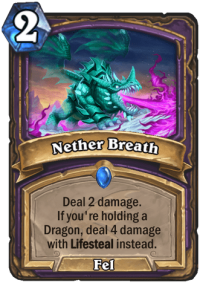
The first, more popular strategy is about taking on the Control role – accept that you play from behind and try to preserve as much life as you can, remove all the minions, Taunt up and stabilize. In the early game, your goal is to use your single target and AoE removals to deal with whatever minions your opponent plays. Nether Breath and Dark Skies are MVP cards in this strategy – first one as a single target removal, and the other one as AoE. Remember that you CAN play Nether Breath even without Dragon in your hand – it will just deal 2 damage for 2 mana, which is not good, but you might just need to play it at times. Let’s say that you face a very aggressive deck that goes first and your opponent plays a 3/2 on Turn 2. In this case, I would definitely play Nether Breath even with no Dragons in your hand. Tapping here instead is risky, because next turn Breath will be off-curve and you might not even get a Dragon to activate it.
When it comes to Dark Skies, there are two important numbers. If you pass or play Mortal Coil on T1 (that will cycle), then Tap on T2, Dark Skies will deal 7 damage when going first and 9 damage when going second. Your opponent isn’t very likely to put more stats on the board, outside of some Edwin VanCleef shenanigans. However, just to be sure, calculate the total health of your opponent’s minions! If it won’t clear everything, then you might consider doing some other play, like using Nether Breath as a single target removal this turn and then trying to remove everything else with Dark Skies next turn. One thing that players don’t really think about is using Soulfire as a removal. Long story short – if you have no other good ways to remove something, use Soulfire. Yes, you will lose a card. But this deck has no card that you really can’t afford losing vs Aggro, and if you won’t kill an early minion, take damage you are going to take over the next few turns will stack.
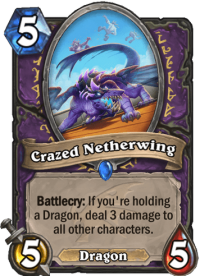
In the mid game, your goal is to start dropping big minions and stabilize that way. You can’t play from behind forever – in fact, your deck is not amazing at playing from behind, since it tends to be proactive. The best strategy is to start by dropping one big minion while you’re still pretty high on health. Your opponent is most likely going to ignore it completely and go face, but the minion will pay for itself. Given that your minions have high health, they will be able to do many trades over a few turns. You can also use Sunfury Protector to Taunt it up. A good way to switch is Crazed Netherwing, because you can do both at the same time – remove minions AND drop a solid body. 5/5 isn’t biggest, but it’s a good start and should be able to give you 2-3 trades. But even a Giant or Twilight Drake is something you just need to play even at the cost of some health. Once you clear the board and stabilize, try to kill them as quickly as possible – the longer you wait, the higher the chance that they will find some burn damage to finish your off is (especially in case of Hunter, which also puts you on a clock with Hero Power).
If you’re nearly dying, try to keep yourself alive until Turn 9 – then once you drop Alexstrasza and heal to 15, you should be safe. You can go for some bad plays even if they will just keep you alive. Alternatively, if you’re dead on the board and can’t do anything about it, you can still try to find some healing from Hero Power or Firetree Witchdoctor. Remember that even if your opponent has no minions, you can still use Nether Breath on his face (or if you find Siphon Soul, you can hit one of your own minions). You can also get some extra healing by combining Zilliax with SN1P-SN4P – extra 2 healing for 3 mana is not great, but it can save you (and you can even heal for more if your opponent has to hit the minion to go through).
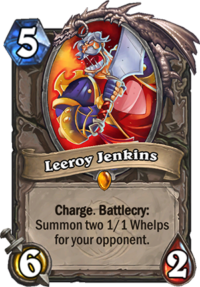
The second strategy is to switch up the roles and try to rush them instead. I know that it sounds crazy, but hear me out – it’s often the best way to play the deck. While it will rarely work out against Face Hunter, if you face a slightly slower aggressive build OR your opponent simply has a slow opener, you might be able to open with a T4 Giant and instead of using it to trade, hit your opponent’s face. The thing is that even though you will most likely start at lower health at that point, you will have a very quick clock. Giant alone is 4 turns clock, but if you drop a second minion on T5 then you can reduce that clock to 3 turns pretty easily. Now you can go two ways – either Taunt up while still going face, or use your other cards to remove your opponent’s minions while keeping yours alive and hit face with big minions. You also have a lot of potential reach from hand thanks to Leeroy Jenkins, Nether Breath, Soulfire etc. Sometimes you drop Giant on T4, hit once on T5 and drop another minion, then hit with everything on T6 and finish the game from hand. In lots of cases, you will be able to kill them faster than they kill you, especially if you weave in some removal of healing.
Vs Control
When it comes to Control matchup, you’ll be playing as an aggressive side nearly every single time. Even though Handlock might seem like a slow deck, with multiple high cost cards, it’s NOT a Control deck and that’s something you need to keep in mind. Not only you draw a lot of cards throughout the game (with Hero Power and Valdris Felgorge), meaning that you will hit fatigue much earlier, you don’t really have a lot of “value” generators – most of your high cost cards are just big threats. That’s why, when you face a slow deck like Control or Combo, you will want to take on the Aggro role – with a combo finisher (but more about that later).
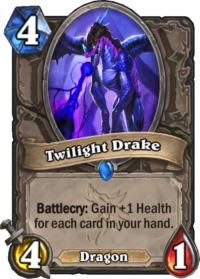
Your goal is to drop a big threat as quickly as possible and then continue doing so as much as you can. Turn 4 is the most key turn in your deck – starting with a Mountain Giant will increase your win rate heavily. Your opponent might have no way to clear it on curve, and if he doesn’t, you should be able to get some serious damage in. Twilight Drake is also good, but a bit worse because it’s only 4 damage as opposed to 8, making it a smaller threat (plus it can be “cleared” with Silence). After Turn 4, you want to drop some minions as often as you can. While you have no amazing 5-drop, you can e.g. get out another Giant/Drake, or maybe even Tap + play something smaller. On T6 Abyssal Summoner is your best bet – it produces a big minion, and even if your opponent finds a removal for the Taunt, you still have a 2/2 (not great, but better than nothing).
However, it’s also important to know removals available to your opponent to not overextend. You aren’t really scared of damage-based removal (dealing 2-4 AoE damage to your board is rarely doing that much), but you’re a bit scared of “board wipes” such as Brawl or Twisting Nether (not common right now). At the time I’m writing this, it means that you’re most afraid of Priest removals – Mass Hysteria is good if you have multiple big minions on the board, while Plague of Death just straight up wipes everything. Then, there are any Highlander builds – if you’re playing against one, take into account that Zephrys the Great is “get out of jail free” card, as he will provide the necessary removal even for the decks that don’t run it (such as Highlander Rogue). Learn opponent’s AoEs and try to play around them. If you don’t think that he can AoE down your board – develop as much as you can. If he can, 2 big minions on the board at the same time (+possibly some smaller ones) is a sweet spot. Then a single target removal won’t be enough, but AoE won’t hurt you that much.
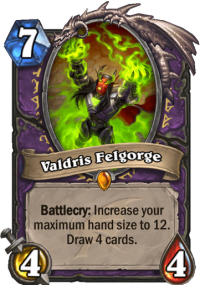
Valdris Felgorge is an MVP. Not only he gives you more steam to work with, brings you closer to the cards you need, but also lets you hold 12 cards in hand, meaning that you can have 1 mana Giants and 11 Health Twilight Drakes, both of which are pretty good. Keep in mind, however, that you need to have 8 cards in hand before playing Valdris (assuming you can’t play anything after). However, if Valdris is your best play on the curve and you have 9 cards, so you will burn one, I honestly would say that you should play him anyway.
And finally, it’s important to note that you run A LOT of burn from hand. Sometimes just 2-3 hits with your bigger minions is enough to then finish the game. One of the cool ways to close out the game is Malygos, but don’t get too hung up on it – most of the time it’s not necessary. Without any mana discounts, you can just deal 9 damage with Malygos + Soulfire. However, if you manage to play Frizz Kindleroost before you draw Malygos, it gets down to 7 mana, which means that you can add another burn spell – either another Soulfire (a bit risky, because you can discard a second copy) or Nether Breath. Either way, you can deal 18 damage, which is pretty solid. You also play Leeroy, which is “only” 6 damage, but it can be combo’d with Nether Breath(s) or Soulfire(s). Even 2x Crazed Netherwing is 3 damage each. Sometimes you will finish games with plays like Netherwing + Nether Breath + Soulfire (11 damage).
Handlock Card Substitutions
Most of the Handlock builds are in the 12k-18k Dust range, making them some of the most expensive decks in the meta. This particular build costs ~15.5k Dust. While some of the expensive cards are key, you CAN substitute most of them. Here’s a full list of Epics & Legendaries with potential replacements (if applicable):
- Dark Skies – It’s a really powerful board clear for Handlock, the fact that you can deal 7 / 9 damage on curve makes it very strong against Aggro. But I guess that if you don’t have it, you could try either Shriek (if you face more really aggressive decks) or Hellfire (against slightly slower builds).
- Mountain Giant – Giant is a vital part of the deck and it can’t be replaced. It’s probably the strongest card in your deck, dropping it on curve increases your win rate heavily. Definitely craft it, because it’s been a viable card for years now.
- SN1P-SN4P – It was given out for free a while ago, so most of you should have it, but even if you don’t, don’t worry – it’s not a necessary card. You can run Scalerider or Earthen Ring Farseer instead.
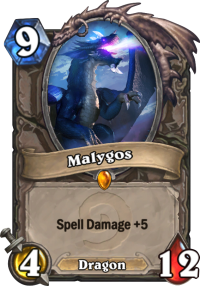
- Frizz Kindleroost + Malygos – Frizz is MOSTLY played for the sake of Malygos, but discounting some other Dragons is also not a bad deal. On the other hand, Malygos is good, because it adds a solid finisher in lots of games. Those come as a package, though, so if you don’t have one of them, you want to cut both (which you CAN do). Faceless Rager, Big Ol' Whelp, Khartut Defender, or the 3-drops I’ve listed above are some okay replacements.
- Leeroy Jenkins – Leeroy is good in the deck, because, like I’ve explained in the strategy part, you’re playing aggressively a lot of time. It’s also one of the best Legendaries to craft, since it’s been played in virtually every meta in the last few years. But it’s also not necessary, I would use any of the replacements listed above.
- Zilliax – By far THE BEST Legendary ever since it was printed back in 2018, I don’t think it has ever dropped below 20% play rate (and it reached 50% or more in some metas). Most of the players have it already, but if you don’t have it, I would not craft it anymore unless you have a lot of Dust to spare (since it will rotate out in the next set). The card is great, but not absolutely necessary – you will probably want to play another defensive/healing card instead, such as Earthen Ring Farseer or Khartut Defender.
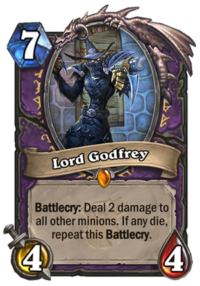
- Lord Godfrey – Godfrey is a good AoE – I like it mostly because it can clear even big boards as long as you can set it up + it often gets rid of minions with Divine Shield or Deathrattle that summons other minions. Still, you can replace it with some other option. Twisting Nether is most likely your best bet, but it’s also Epic. Alternatively, you can try out Hellfire or Shadowflame.
- Valdris Felgorge – Valdris is a very good card in Handlock, it’s basically an auto-include, but mostly as a “generic, good card”, not a card that’s key to your strategy. In other words, you can live without it. There’s really no direct replacement for it, so you can use any of the replacements listed in there (mostly depending on what other cards you’re missing).
- Alexstrasza – I really, really like Alexstrasza in this deck. Not only it’s an expensive Dragon (so once you draw her, all of your Dragon synergies will remain active for a while), but it saves your life in lots of matchups (mostly against Aggro). If your opponent has any kind of burn etc. and brings you down in the range (usually below 10 health), getting back up to 15 is crucial. At the same time, in slow matchups you can trim down opponent’s health before doing Malygos or Leeroy combos (or, if you already have 11 damage on the board, you can play Alex + hit with your minions + Soulfire to kill them). All of that said, the card is – once again – not absolutely necessary. I would probably play another Dragon instead, though, ESPECIALLY if you also don’t have Malygos. You can replace Alex with another big Dragon like Dragonqueen Alexstrasza (yes, it’s not a Highlander deck, but you do tap a lot) or Zzeraku the Warped. If you don’t have those either, second Evasive Drakonid or Big Ol' Whelp are probably your best options.
Leave a Reply
You must be logged in to post a comment.








This is one of those archetypes that looks really fun but holy crap is it expensive. SK’s recommended substitutions help if you’re just missing a handful, but I’m missing so many it wouldn’t even resemble this deck list. I do at least get a little exposure to this through Whizbang–man am I going to miss that card when it’s gone. 🙁
I can vote on this. This is good one. So many pros I can list.
who can guess that Spellbreaker can help for Lethal if they had taunts.
Malygos is indeed powerful enough to deal lethal at turn 10 after Alex did her thing. Even if the enemy still alive after, you just can deal spells to face.
All that while provided a good heal with Zilliax / Nether Breath, and still provides with lots of draws.
This is so good even without Godfrey in it, replaced it with Doomsayer or Twisting Nether.
I prefer not to craft Godfrey because it’s expensive, and he rotates out soon.
Now cons..
Don’t risk trying to double Soulfire for lethal. I had to concede thinking Malygos and 1 coins could do lethal for 18. but in a 1 to 8 cards I had in hands, it still randomly discard my 2nd Soulfire.
My luck is just that bad.
And when it comes to Discarding method, I really prefer Yugi-oh method where you can always pick the cards you want to discard. Not by some random pick (unless it was stated, e.g the lowest card). That way, I can still put some strategy into play.
I agree that that’s a vastly superior way to do it, but I suspect it would be a huge software burden to implement in current Hearthstone.
Legends of Runeterra does the “you pick” method too, incidentally, and I think because of that it looks like some discard-heavy decks will be viable whereas in Hearthstone it’s mostly limited to either a finisher or a desperation play.
huge software burden? I don’t think so.
does Unity programming is hard? Yes.
does it hard to just program a method to pick card to discard? Not really.
it’s similar as picking a card to play.
If I were to ask them to create a discard pile like “Graveyard” in Yugi-oh, then it is harder.
because then they would have to redesign the whole combat background.